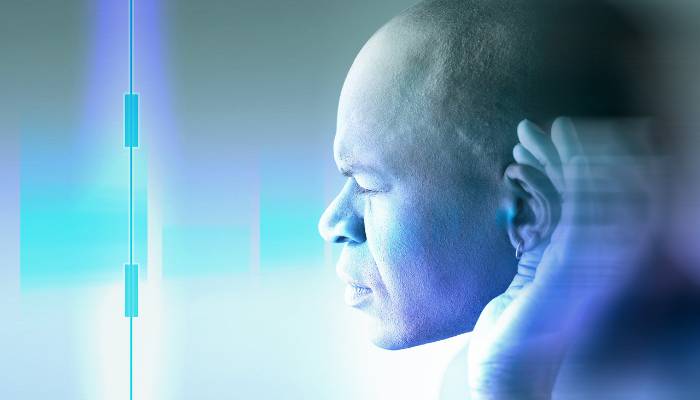Nearly 1 in every 5 people of all people suffer from some form of tinnitus, mostly older adults. There are many possible causes, including natural hearing loss in older adults, damage to the sensitive hairs that detect sound within the inner ear, or even problems involving the circulatory system. Hearing loss can be gradual and more accurately determined through a hearing loss test, while conditions such as tinnitus are a little more obvious.

Most people describe tinnitus as a “ringing” sound in the ears that other people cannot hear. Despite that common descriptor, tinnitus can take the form of a wide variety of different sounds.
What Does Tinnitus Sound Like?
People suffering from tinnitus experience a relatively diverse amount of sound variations, each hearing different versions. Most of the time, an individual will only hear one type, although it is possible to hear different tones if the person experiences tinnitus in both ears.
Regardless of the type of sound, they can be distracting and annoying, especially in a quiet room, such as when a person is trying to sleep. Sometimes these phantom noises can disrupt a person’s life to the extent that they have trouble focusing on whatever they may be doing, sometimes leading to anxiety or depression.
Here are some of the most common sounds that people with tinnitus describe:
Tone Variations
This sound is a consistent tone that never ends. Some people describe it as a high-pitched electronic whine, such as you might hear from an idle computer or some other technological device. This tone can exist at different frequencies; some commonly experience tones at 4000 hertz or 7500 hertz, with the latter being a higher-pitched sound.
Tea Kettle Whistle
Another reported variation of tonal tinnitus has a grating edge, similar to a tea kettle’s whistle when the water reaches a boil. However, for those who suffer from this sound, there is no way to take the pot off the stove to make it end. It persists continually, even more prevalent if you place your hands over your ears. This is because the sound is internal, not the result of an external sound.
Buzzing Cicada
If you have ever heard the chirp of a cicada around dusk, you have a general idea of what the buzzing tinnitus sounds like, only the sound remains a consistent tone at a stationary volume. This form of tinnitus often is higher pitched and sounds like two dissonant tones playing simultaneously.
Static
Most people are familiar with the sound of static. This generally happens when a television station goes offline, or the cable is out; it can also occur on the radio when the signal is weak or when a thick structure or inclement weather disrupts the transmission.
Whatever the case, most people find static an unpleasant sound and immediately turn down the volume or turn off the television. However, when the sound is in your head, there’s no recourse but to find other methods to alleviate the sound.
Metal Scraping
Have you ever heard the screeching sound when a worker uses a metal grinder to shape or finish metal? The sound happens as the sparks fly, often ringing loudly. This sound is reminiscent of one form of tinnitus, an unwavering version of metal buffing.
Roaring
For other people, their tinnitus sounds like a mighty roar, like what you might hear when waves crash against rocks along a shoreline. Some white noise generators even use the sounds of crashing waves to help people sleep, but unlike the ebb and flow of the tides, the roar is a static (unchanging) sound captured at the height of the roar.
Vacuum Whoosh
You may have realized at this point that many of these versions of tinnitus are different. The same is true of the whooshing sound, which resembles an electric vacuum cleaner’s sound while on and idling. This whoosh is a similar sound, with an electric vibe throughout.
Other Variations
Those five versions of tinnitus are far from the only ones. Some people experience strange clicking sounds, while others hear hissing, siren-like sounds, vibrant pulses, cricket-like chirps, or even what sounds like music playing! Each person’s experience is different as the range of different sounds manifests in unique ways for each person.
What Causes the Phantom Sounds?

Tinnitus isn’t limited to a single cause. Still, the most common occurrence is when the sensitive sound-detection hairs within the inner ear suffer damage, often from prolonged exposure to loud noises or as a natural result of aging, causing them to lie down. This often results in hearing loss, but damaged hairs can malfunction, erroneously detecting sounds that are not there.
Other times, brain-related ailments or hormonal issues can result in the brain misinterpreting signals sent from the hairs, with the same result. In some circumstances, problems with the circulatory system or inner ear can result in roaring or pulsing sounds which can be audible to doctors when they insert a small microphone within the ear canal.
How Can I Treat Tinnitus?
In most cases, tinnitus will go away on its own, mainly if it results from a known stimulus, such as attending a loud concert for a few hours or a respiratory infection. However, you should consult a medical professional if the problem does not go away within six weeks.
If the tinnitus results from a specific medical issue, it will often go away after treating that underlying cause. In other instances, some medications have proven effective in eliminating or reducing the effects of tinnitus.
In many cases, however, tinnitus becomes a life-long ailment. Most people live their lives, as usual, adapting to the phantom sounds with little discomfort. In more severe cases, people often use masking devices such as loud fans, music, white noise machines, television, and other devices because they can reduce tinnitus to background noise.

Lifebing is driven by an unrelenting passion for promoting health and well-being, our team is wholly committed to curating exceptional content and immersive experiences.
